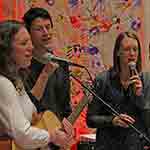
Blueprint Church is a pioneer mission unit of the Wellington Diocese, founded in 2013 as part of the new way forward envisaged by Bishop Justin Duckworth who took up leadership of the Wellington Diocese half way through 2012.
Now, Blueprint has produced “an album of contemporary arrangements for corporate worship drawing on the Eucharist liturgies, Night Prayer and the Daily Offices from A New Zealand Prayer Book / He Karakia Mihinare o Aotearoa.” The album is called Reconciled.
You can read an article about this on the online Taonga site. This says that “The album is free to all on Spotify, iTunes, and at reconciled.co.nz from today. Parishes wanting chord charts can request them from blueprintchurch@gmail.com”.
Actually, as far as I can see, each track on iTunes is $NZ 1.79. And the chords are already available on the Reconciled website (and, Taonga notwithstanding, I can’t find the recording, free or otherwise, on that Reconciled website).
The album is free on Spotify.
I really like what I’ve heard. The lyrics are easy to hear. The harmonies are delightful.
I cannot ascertain, simply by listening to this, whether this material is, at Blueprint, generally sung by the band or is it also sung by the whole community? How easy is the material for congregational singing?
I am intrigued where the lyrics follow the NZ Prayer Book texts and where they altered them. And why? Did they start with a tune and find the Prayer Book words simply didn’t fit? Or do they think that their words improve the Prayer Book’s?
We need new, creative ways forward to be Christian communities in today’s world. And we need new ways of worshipping. Blueprint and Reconciled are giving this a go.
And Jesus said to them, ‘Therefore every scribe who has been trained for the kingdom of heaven is like the master of a household who brings out of his treasure what is new and what is old.’
What do you think?
If you appreciated this post, consider liking the liturgy facebook page, and/or signing up for a not-very-often email, …




Fr. Bosco, I love it–it’s interesting that part of the reason I moved away from the evangelical church to the Episcopal Church years ago was my distaste for contemporary worship music. But this is quite lovely. The words being taken from the Prayer Book must help! In my contexts as a parent and a school chaplain I could see it being quite useful. Thank you for the recommendation.
Thanks, Andrew. We need quality contemporary Christian music with depth – this album gives a way forward. Blessings.
Hi Bosco
Scottie Reeve here (Rev at Blueprint). A bit of history:
As a pioneer mission unit we were looking at how to introduce the Eucharistic liturgies into our service. What we’d had up until February this year was quite protestant pentecostal in flavour. We sent away our team to Ngatiawa River Monastery with a number of pieces of liturgy late last year and had them spend a weekend together. We started introducing these songs in January as we moved towards a more liturgical Eucharist.
The majority of those playing on the album live in intentional communities who use the prayer book daily so already had an affinity and passion for helping other young people to get their head around it.
Regarding any changes, we tried to be respectful to preserve the integrity of the meaning of each phrase. But sometimes we just needed things to flow a little more naturally lyrically so we made little adjustments here and there. I guess this is the compromise of contemporary worship and liturgy.
We sing all these songs corporately at Sunday services. The first song on the album, The Invitation, stops in the middle where we do an invitation, absolution, and communion. So it ends up being quite a large piece of liturgy that feels less overwhelming and traditional to the age and stage of our congregation.
Thanks for your interest Bosco. I am on a Te Wananga course with your son, and your book was really formative in my journey of explaining the Eucharist to young adults – “not prescriptive, but descriptive!” We actually did five weeks of teaching on what the “inward grace” is that we’re expressing in Eucharist before we started breaking bread together. It’s been a fun journey.
Thanks SO much for that framing, Scottie. St Gregory of Nyssa (San Francisco) and Taizé are two places that immediately spring to mind for translating the ancient into the contemporary. Both have a strong musical dimension. There’s more connections – from the photo, I have taught at least one of the people in the Blueprint group! I’m pleased Celebrating Eucharist connected – I’m working on a chapter in a book of articles as we speak which will develop the “not prescriptive, but descriptive!” idea. And I still think my video at the start of this page is one of my best work. Blessings.
I think that the issue Father B, is that Anglican Taonga has confused iTunes with Music. At the bottom of the page on the Reconciled website, there is a link to Music, not iTunes. If you subscribe to Music, then you can listen to the album free, with all the rest of Music’s playlist.
Ah. Thanks, David. Blessings.